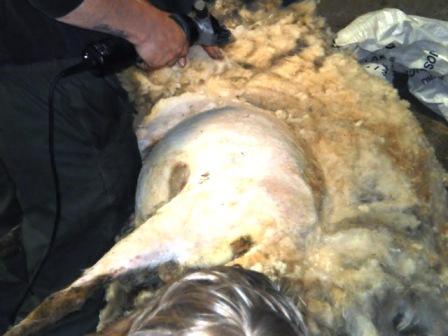When you shave your face, you cut all of the hair off down to the skin. When you shear a sheep, you leave about 5mm of wool on the animal.
Shearing we usually do in June. May and early July also. Then it's warm enough to let the sheep outside without a coat. It depends on the weather (hot and dry),...
Nowadays, there is also shorn in the winter. The farmer has more time. The animals are still kept inside. They take up less space in the shed. And gestation (thicken, udder swelling) is to follow better.
 Close them in the evening already. Then you don’t have to run behind them to get them caught. And they cannot eat, they stay sober. Thus you avoid shearers disease.
Close them in the evening already. Then you don’t have to run behind them to get them caught. And they cannot eat, they stay sober. Thus you avoid shearers disease.
A cast sheep is one that lies on his back and cannot get up. Help is needed quickly. It should be turned over quietly and be helped up. The intestines when supine laying press on lungs and spine. The animal will thus choke after a period of time. A cast sheep that is quickly rolled over and put on the legs, runs a high risk of bloat or gastric torsion. The gas formed in large quantities in the gastrointestinal tract in all ruminants, cannot escape, leading to coma ,and death can result.
This bloat is here also called the shearers disease because it often happened after shearing. If they have not eaten, no gas is formed. Don’t roll the animals over their backs when shearing.
Put them in warm, dry weather and when the sheep are dry on a clean and dry surface (a sail, pure grass...), then the wool stays clean. Because of the heat (in the barn), the wool grease is softer. That works easier.
The wool is soiled with grease, sweat, grass and plant remains. Around the anus of the sheep is also stool. That you can cut away with scissors. Wool that is not too dirty, you can still wash, and possibly use for felt. By washing the wool dirt is removed, but possibly fat too. For spinning, it is useful if the wool is still somewhat fat. Therefore prefer not to use hot water because it dissolves fat (partially).
To shear an electric clipper operates convenient and fast. There is also a hand -operated version. That makes no noise. But the work is heavier and lasts longer. The simplest and oldest razor scissors or sheep shears is also sold as a shrub shear to prune buxus nowadays. You can thus also use those. Calculate as a beginner half a day. Per sheep. Wear finger protection, gloves or patches. You do constantly not all - day movements. Before you know it you have blisters.
You have one hand in order to cut, and one to feel and push wool away, so you see what you're doing. Otherwise, you may cut into skin, groin, penis, udder. So be cautious. Do you still cut a wound, disinfect it.
Put the sheep on her butt, her shoulders to your knees. Cut close to the skin from top to bottom and front to back. Since you need two hands, you hold the sheep usually fixed by holding the head between your legs. Do not give it a chance to escape before the job is done.
This also includes worming and hooves cut. With secateurs and /or a knife you cut away any loose pieces.
Keep colored and white wool separately.
